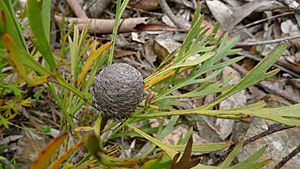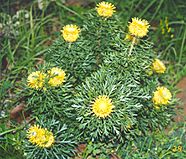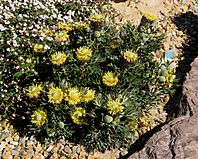Broad-leaved drumsticks facts for kids
{{Speciesbox | image = Isopogon anemonifolius 01.jpg | image_caption = In Royal Botanic Gardens, Cranbourne | genus = Isopogon | species = anemonifolius | authority = (Salisb.) Knight |synonyms_ref =
| synonyms =
- Atylus anemonifolius (Salisb.) Kuntze
- Isopogon anemonifolius (Salisb.) R.Br. isonym
- Isopogon anemonifolius (Salisb.) Knight f. anemonifolius
- Isopogon anemonifolius f. simplicifolia Cheel
- Isopogon anemonifolius (Salisb.) Knight var. anemonifolius
- Isopogon anemonifolius var. glaber R.Br.
- Isopogon anemonifolius var. pubescens R.Br.
- Isopogon anemonifolius var. pubiflorus Benth.
- Isopogon tridactylidis (Cav.) Roem. & Schult.
- Protea anemonifolia Salisb.
- Protea anemonifolius J.Wrigley & Fagg orth. var.
- Protea apifolia Meisn. nom. inval., pro syn.
- Protea tridactylides Cav.
Isopogon anemonifolius, also known as broad-leaved drumsticks, is a type of shrub. It belongs to the Proteaceae plant family. This plant grows naturally only in eastern New South Wales, Australia. You can find it in woodlands, open forests, and heathlands. It prefers sandy soils.
This plant usually grows between one and two metres tall. In very open heathland, it tends to be smaller. Its leaves are divided and narrow. They are wider than those of its relative, the Isopogon anethifolius. In cooler months, the leaves can turn a bit purplish. Bright yellow flowers appear in late spring or early summer. After the flowers, round grey cones grow. These cones look like drumsticks, which is how the plant got its common name. Inside these old flower parts, you can find small, hairy seeds.
Isopogon anemonifolius is a long-lived plant. It can live for up to 60 years! After a bushfire, it can regrow from its woody base, called a lignotuber. New seedlings often appear the year after a fire. This plant was first collected by Daniel Solander in 1770. However, it was officially described in 1796 by Richard Salisbury. People started growing it in gardens in the United Kingdom in 1791. It's quite easy to grow in a garden. It just needs a sunny or partly shaded spot with sandy soil that drains well.
Contents
What Does It Look Like?
The broad-leaved drumsticks plant is an evergreen, woody shrub. It usually grows to about 1 to 1.5 metres (3 to 5 feet) tall. However, in very open areas like heaths, it might only reach about 50 centimetres (20 inches).
Its leaves are 5 to 11 centimetres (2 to 4 inches) long. They often split into three parts. Sometimes, they split a second time. The tips of the leaves are pointed. Interestingly, some leaves on the same plant might not be divided at all. The leaves are usually smooth. Sometimes, they have fine hairs.
These flat leaves help tell it apart from the Isopogon anethifolius. That plant has round leaves. The leaves of Isopogon anemonifolius are also wider. They are 3 to 5 millimetres (about 1/8 to 3/16 inch) wide. The new leaves can be reddish to purple, especially in winter.
The flowers grow in round clusters called inflorescences. They appear from July to January, but mostly in October. These clusters are 3 to 4 centimetres (1 to 1.5 inches) wide. They grow at the ends of branches. Each flower is about 1.2 centimetres (half an inch) long. They have a tube-like part called a perianth that covers the flower's inner parts. This tube splits into four parts. Inside, you can see a thin style with a stigma at its tip. At the end of the perianth parts are the anthers, which hold pollen. The flowers open in a spiral pattern, from the bottom upwards.
After flowering, the plant develops round fruiting cones. These cones are 1 to 1.6 centimetres (about half an inch) wide. The seeds inside are very small, less than 4 millimetres (about 1/8 inch) across. They are covered with hairs.
How It Got Its Name
In 1770, a Swedish scientist named Daniel Solander found this plant. He was with Captain James Cook on his first voyage. Solander called it Leucadendron apiifolium. This name meant its leaves looked like celery (Apium). But he never officially described it.
Later, in 1796, an English botanist named Richard Salisbury formally described the plant. He named it Protea anemonifolia. The name anemonifolia comes from "anemone" and "folium" (meaning "leaf"). This was because its leaves looked like those of anemones. The common name, drumsticks, comes from the shape of its round cones.
In 1809, the plant got its current name: Isopogon anemonifolius. This happened in a book written by Salisbury but published under Joseph Knight's name.
Where It Grows
You can find Isopogon anemonifolius along the east coast of New South Wales. It grows from near the border with Victoria almost up to Queensland. It's most common between Smoky Cape and Ulladulla. There's also a separate group of these plants near Torrington in the New England area.
This plant grows from sea level up to about 1,200 metres (3,900 feet) high. It likes sandy soils that don't have many nutrients. You'll often see it in heathland and dry sclerophyll woodland. It especially likes ridges or hilltops.
It often grows with other native trees. These include scribbly gums (Eucalyptus haemastoma), yellow bloodwood (Corymbia eximia), and smooth-barked apple (Angophora costata). In heathlands, it grows with plants like rusty banksia (Banksia oblongifolia) and mountain devil (Lambertia formosa).
How It Survives and Thrives
Isopogon anemonifolius is a very tough plant. It can live for up to 60 years. After a bushfire, it can regrow from its special woody base, called a lignotuber. This regrowth usually starts about two months after a fire. The new growth takes about two years to produce flowers. Older plants with bigger lignotubers can regrow even faster.
This plant grows slowly. Its lignotuber grows about 0.173 cm for every existing cm each year. This means a lignotuber might be 1 cm (0.4 inches) wide at 10 years old. It could be 5 cm (2 inches) wide at 20 years old. The biggest lignotubers found have been 40 cm (16 inches) wide.
To survive small fires, plants need a lignotuber at least 2 cm (0.8 inches) wide. After about 15 years, plants can survive even hotter fires. This plant is also serotinous. This means its seeds are stored on the plant in cones. They are only released after a fire. Most new seedlings appear within a year after a bushfire. Very few appear at other times.
The seeds usually fall directly to the ground. Sometimes, the wind blows them a short distance. Young plants start flowering about seven years after their seeds sprout. If bushfires happen too often (less than every 10 years), it can harm the plants. This might lead to fewer plants over time. For the plant population to stay healthy, fires should be at least 12 to 15 years apart.
Sometimes, a fungus called Vizella can cause Leaf spots. Also, small insects called weevils can damage the flower buds.
Growing Broad-leaved Drumsticks
Isopogon anemonifolius was first grown in gardens in the United Kingdom in 1791. It's a great plant for gardens because of its attractive leaves and pretty flowers and cones. You can plant it in rock gardens, along borders, or even in a pot.
These plants can grow in different ways. Some grow upright, while others spread out. Some types naturally stay small without needing much pruning. It grows best in sandy soil that drains well. It likes a sunny spot or a place with some shade. This plant can handle light frosts and dry periods. However, it will produce more flowers if it gets enough moisture. Once it's established, you can prune it quite a lot.
You can grow new plants from seeds or from cuttings. Cuttings should be taken from new growth that is less than a year old. You can collect the seeds from the cones and store them. It's best to plant them in spring or autumn. The stems and flowers last a long time in water. Because of this, the flowers, cones, and leaves are used in the cut-flower industry.
There are also special smaller types of Isopogon anemonifolius. One is called 'Woorikee 2000'. It's a dwarf form that produces many flowers. Another small type is called 'Little Drumsticks'.






